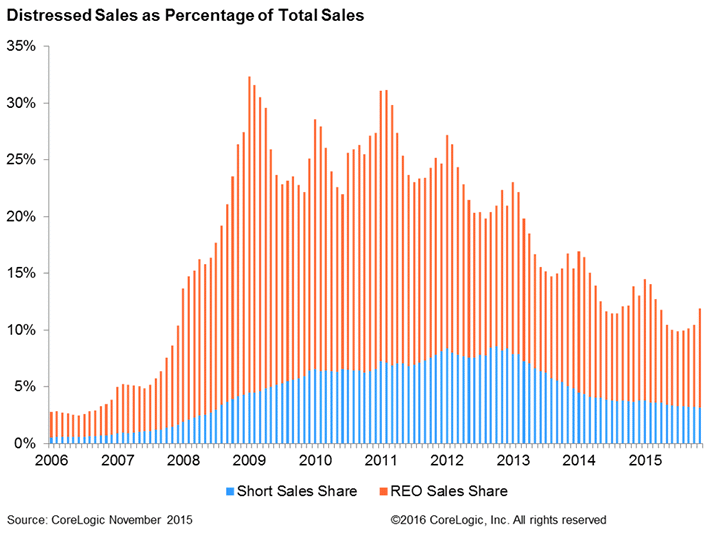There was a slight uptick in the market share of distressed home sales in November. Sales of lender-owned houses (REO) and short sales accounted for 11.9 percent of total home sales nationally, a 1.4 percent point gain over those sales in October. The share was, however, down 1.9 points from November 2014.
In releasing the November numbers CoreLogic said the month-over-month increase was a factor of seasonality and was in line with blips in previous Novembers. Distressed home sales were still the lowest for any November since 2007.
REO had an 8.7 percent portion of all sales with short sales making up the balance of the distressed share with 3.2 percent. The REO sales share was 1.5 percentage points below that in November 2014. The short sales share fell below 4 percent in mid-2014 and has remained in the 3-4 percent range since then.
At the peak in January 2009, distressed sales held a 32.4 percent share of the home sales market with REO sales representing 27.9 percent. CoreLogic notes there will always be some level of distress in the housing market, and by comparison, the pre-crisis share of distressed sales was traditionally about 2 percent. If the current year-over-year decrease in the distressed sales share continues the company predicts it will reach that "normal" 2-percent mark in mid-2019.
All but nine states recorded lower distressed sales shares in November 2015 compared with a year earlier. Maryland had the largest share of distressed sales of any state at 20.2 percent followed by Connecticut (19.1 percent), Florida (19 percent), Michigan (18.9 percent) and Illinois (17.8 percent). Nevada had a 5.4 percentage point drop in its distressed sales share from a year earlier, the largest decline of any state. California had the largest improvement of any state from its peak distressed sales share, falling 59.2 percentage points from its January 2009 peak of 67.4 percent. Only North Dakota and the District of Columbia are within one percentage point of their pre-crisis levels of distressed sales.

There was little light among those in the 25 largest Core Based Statistical Areas (CBSAs) with the largest distressed sales shares. Orlando area had the highest percentage at 21.2 followed by and Tampa-St. Petersburg, Baltimore, Chicago, and Miami-Miami Beach, all with shares slightly exceeding 20 percent. Las Vegas had the largest year-over-year drop in its distressed sales share, falling by 5.5 percentage points from 20.3 percent in November 2014 to 14.8 percent in November 2015.







